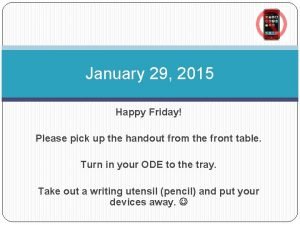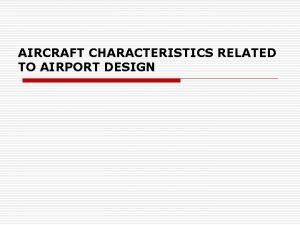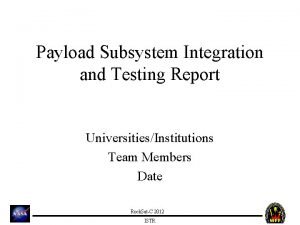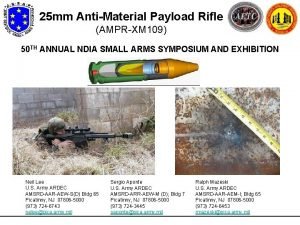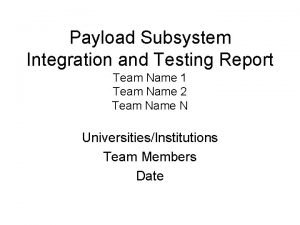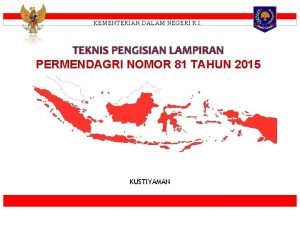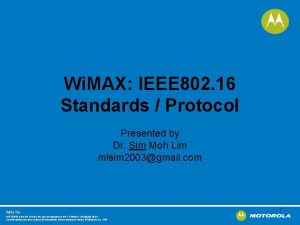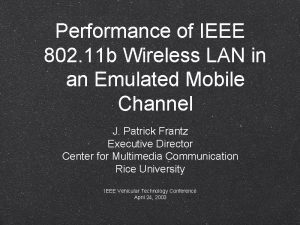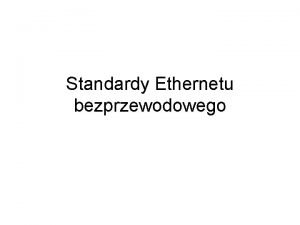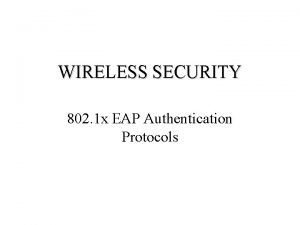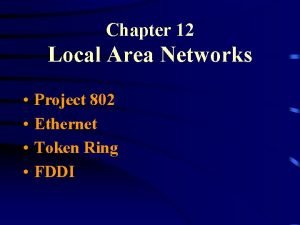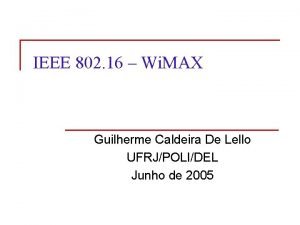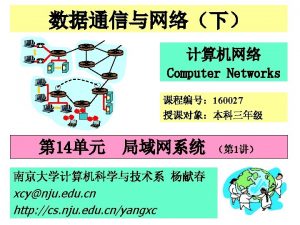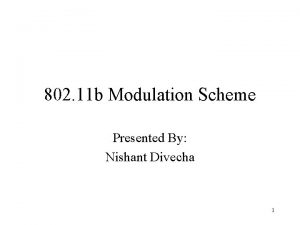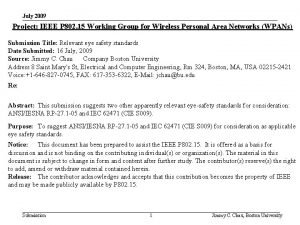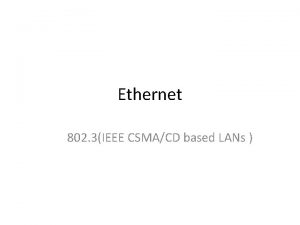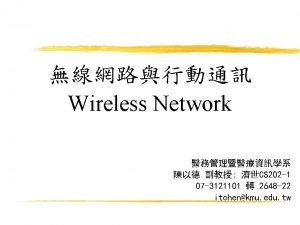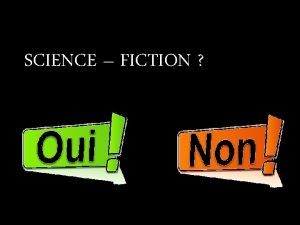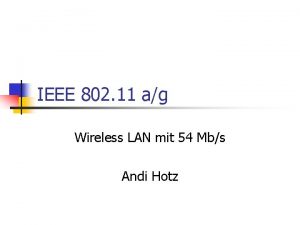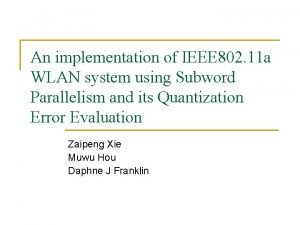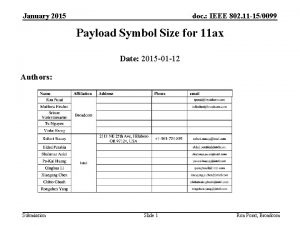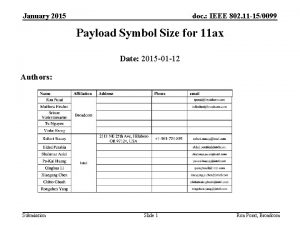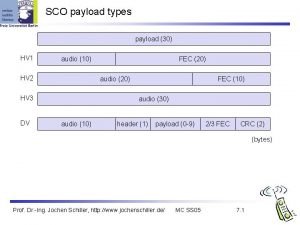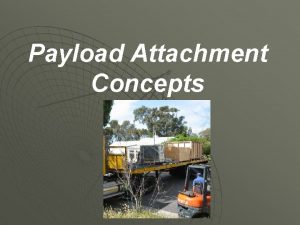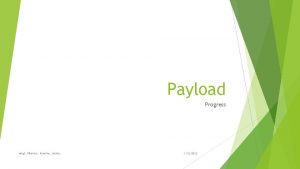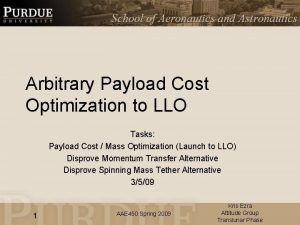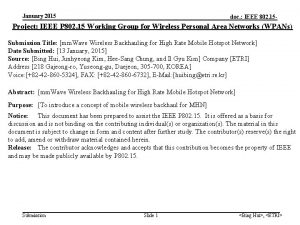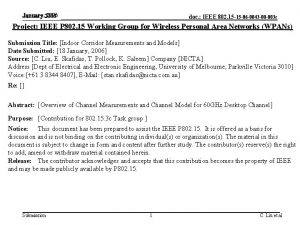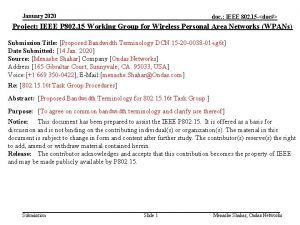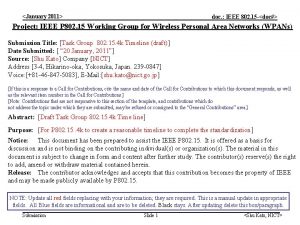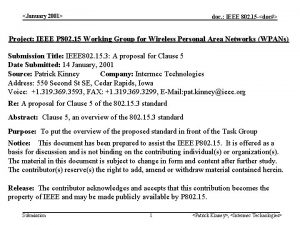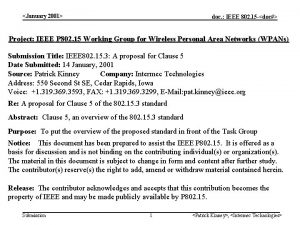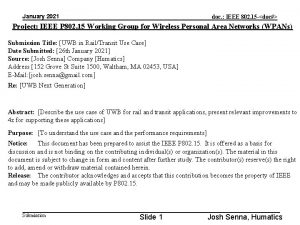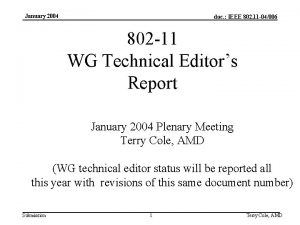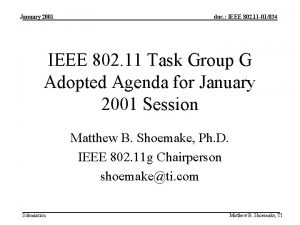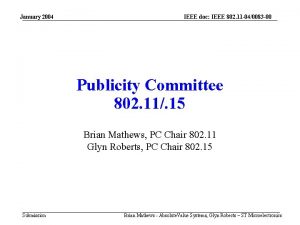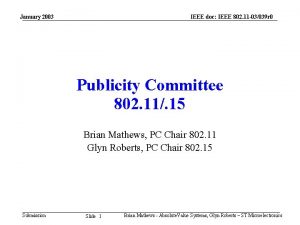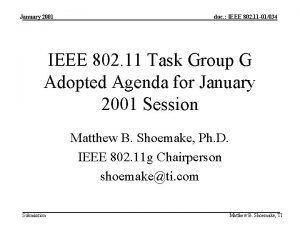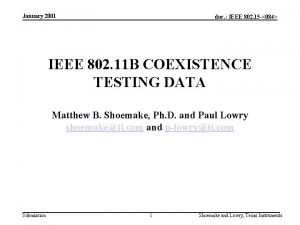January 2015 doc IEEE 802 11 150099 Payload


























![January 2015 doc. : IEEE 802. 11 -15/0099 References [1] 11 -14 -0801 -00 January 2015 doc. : IEEE 802. 11 -15/0099 References [1] 11 -14 -0801 -00](https://slidetodoc.com/presentation_image_h2/731691ceac4a1bf00000ba25b32d934b/image-27.jpg)






- Slides: 33

January 2015 doc. : IEEE 802. 11 -15/0099 Payload Symbol Size for 11 ax Date: 2015 -01 -12 Authors: Submission Slide 1 Ron Porat, Broadcom

January 2015 doc. : IEEE 802. 11 -15/0099 Authors (continued) Submission Slide 2 Ron Porat, Broadcom

January 2015 doc. : IEEE 802. 11 -15/0099 Authors (continued) Submission Slide 3 Ron Porat, Broadcom

January 2015 doc. : IEEE 802. 11 -15/0099 Authors (continued) Submission Slide 4 Ron Porat, Broadcom

January 2015 doc. : IEEE 802. 11 -15/0099 Authors (continued) Submission Slide 5 Ron Porat, Broadcom

January 2015 doc. : IEEE 802. 11 -15/0099 Authors (continued) Submission Slide 6 Ron Porat, Broadcom

January 2015 doc. : IEEE 802. 11 -15/0099 Authors (continued) Submission Slide 7 Ron Porat, Broadcom

January 2015 doc. : IEEE 802. 11 -15/0099 Outline • The need for larger symbol size for 11 ax payloads has been discussed previously – Eg: [1] investigated the impact of CFO estimation on symbols with larger FFT sizes (256 and 512 FFT) • We have investigated several symbol durations for the payload and propose a new symbol duration • We also follow up with a proposal for the choices of CP • The proposals are verified via simulations that show – Significant Goodput gains over 11 ac symbol and CP lengths of 3. 2 us and 0. 8 us respectively – Robust performance in outdoor UL OFDMA Submission Slide 8 Ron Porat, Broadcom

January 2015 doc. : IEEE 802. 11 -15/0099 Payload Symbol & CP Sizes • We propose to replace the current payload symbol duration (3. 2 us) with longer symbol duration 12. 8 us in order to meet the following 11 ax requirements – Robustness in outdoor channels – Greater tolerance to timing jitter across users in UL MU/OFDMA – Higher indoor efficiency (by lowering CP overhead) • We also propose three following CP sizes – 0. 8 us: 11 ac long GI, targeting improved efficiency in indoor settings – 1. 6 us: percent-wise 11 ac short GI, targeting high efficiency in outdoor channels and indoor UL MU-MIMO/OFDMA – 3. 2 us: percent-wise 11 ac long GI, targeting robustness in the more demanding case of outdoor UL MU-MIMO/OFDMA Submission Slide 9 Ron Porat, Broadcom

January 2015 doc. : IEEE 802. 11 -15/0099 Channel models & implications • Outdoor channels – UMi-Lo. S, UMi-NLo. S, UMa-NLo. S • • NLo. S channels have large delay spreads with significant probability Intersymbol interference leads to high error floors 0. 8 us CP leads to error floors Need longer CPs Submission Slide 10 Ron Porat, Broadcom

January 2015 doc. : IEEE 802. 11 -15/0099 Spectral efficiency • • • Assume a fixed transmission bandwidth and choose an MCS R = code rate, bps = bits/sample (in the frequency domain. Eg. 256 QAM, bps = 8) Nfft = symbol FFT size, Ndata = #data tones/symbol, Ncp = #CP samples Increases as Ncp increases Decreases as Ncp increases As PER decreases for ISI channels Unless we increase Nfft Tone utilization Depends only on MCS For a given Ncp (dictated by channel length), increase Nfft for smaller overheads and greater spectral efficiency Submission Slide 11 Ron Porat, Broadcom

January 2015 doc. : IEEE 802. 11 -15/0099 Simulation setup L-STF • L-LTF L-SIG 11 ax Preamble 11 ax-LTF Payload Packet structure – Payload • • 1000 bytes FFT sizes: 64, 128, 256 FFT Data tones as defined for corresponding FFT sizes in 11 ac CP sizes: 0. 8 us, 1. 6 us – 11 ax-LTF: 1 symbol, same (FFT size, GI) as payload – 11 ax-Preamble: 3 symbols, 64 FFT (precise structure undecided now, but # guided by 11 ac) – How is the preamble relevant? • Pilots used for phase tracking, reduce CFO estimation error • • 20 MHz bandwidth, SISO, BCC Real processing – Channel estimation, timing, frequency offset estimation, phase tracking, phase noise: all real Submission Slide 12 Ron Porat, Broadcom ?

January 2015 doc. : IEEE 802. 11 -15/0099 UMi-Lo. S: PER for MCS 0 -4 PERs with 1. 6 us GI (right figure) smaller than PERs with 0. 8 us GI (left figure) Even for a given GI, increasing FFT size reduces PER (ICI corrupted samples is a smaller fraction of the total number of samples) Submission Slide 13 Ron Porat, Broadcom

January 2015 doc. : IEEE 802. 11 -15/0099 UMi-Lo. S: PER for MCS 5 -9 PERs with 1. 6 us GI (right figure) smaller than PERs with 0. 8 us GI (left figure) Even for a given GI, increasing FFT size reduces PER (ICI corrupted samples is a smaller fraction of the total number of samples) Submission Slide 14 Ron Porat, Broadcom

January 2015 doc. : IEEE 802. 11 -15/0099 UMi-NLo. S: PER for MCS 0 -4 PERs with 1. 6 us GI (right figure) smaller than PERs with 0. 8 us GI (left figure) Even for a given GI, increasing FFT size reduces PER (ICI corrupted samples is a smaller fraction of the total number of samples) Submission Slide 15 Ron Porat, Broadcom

January 2015 doc. : IEEE 802. 11 -15/0099 UMi-NLo. S: PER for MCS 5 -9 PERs with 1. 6 us GI (right figure) smaller than PERs with 0. 8 us GI (left figure) Even for a given GI, increasing FFT size reduces PER (ICI corrupted samples is a smaller fraction of the total number of samples) Submission Slide 16 Ron Porat, Broadcom

January 2015 doc. : IEEE 802. 11 -15/0099 Goodput metric used for comparison • Goodput = max spectral efficiency obtained by picking the best MCS (for each SNR) • For a given CP size Ncp, choose largest possible Nfft • CP overhead decreases • For a given FFT size Nfft , there is a tradeoff in choosing Ncp • • • Submission Small Ncp : small overhead, but PER may be large Large Ncp : PER is small, but overhead large Choose the sweet spot for Ncp Slide 17 Ron Porat, Broadcom

January 2015 doc. : IEEE 802. 11 -15/0099 Goodput: AWGN Absolute Goodput relative to (64 FFT, 0. 8 us CP) • For best results, pick as large an FFT as possible and then pick the smallest CP • Increasing CP has no PER benefit in AWGN, increasing FFT reduces overhead • Using (256 FFT, 0. 8 us CP) gives 1. 32 x goodput of (64 FFT, 0. 8 us CP) Submission Slide 18 Ron Porat, Broadcom

January 2015 doc. : IEEE 802. 11 -15/0099 Goodput: 11 n. D Absolute Goodput relative to (64 FFT, 0. 8 us CP) • Using (256 FFT, 0. 8 us CP) gives ~1. 3 x goodput of (64 FFT, 0. 8 us CP) • Since channels have small delay spreads, 0. 8 us CP has 6 -7% better throughput than 1. 6 us CP (256 FFT, around 15 -20 d. B) Submission Slide 19 Ron Porat, Broadcom

January 2015 doc. : IEEE 802. 11 -15/0099 Goodput: UMi-Lo. S Absolute Goodput • At high SNR • • • Goodput relative to (64 FFT, 0. 8 us CP) Best to use large FFT with longer CP (256 FFT, 1. 6 us CP) gives nearly 2. 2 x goodput of (64 FFT, 0. 8 us CP) At small SNR • • Submission Thermal noise dominates ISI: increasing CP doesn’t give substantial PER gains Stick to smaller CPs, but use larger FFTs: (256 FFT, 0. 8 us CP) works best Slide 20 Ron Porat, Broadcom

January 2015 doc. : IEEE 802. 11 -15/0099 Goodput: UMi-NLo. S Goodput relative to (64 FFT, 0. 8 us CP) Absolute Goodput • Large delay spreads leads to high ISI • • Submission Best to use large FFT with longer CP (256 FFT, 1. 6 us) (256 FFT, 1. 6 us CP) gives ~2. 5 x goodput of (64 FFT, 0. 8 us CP) at 25 d. B SNR Slide 21 Ron Porat, Broadcom

January 2015 doc. : IEEE 802. 11 -15/0099 Challenge of UL-OFDMA • Timing jitter across users on the UL effectively increases channel delay spread. What is the impact on performance? – Impact of intended user delay on himself – Impact of delay of interfering users on intended user • Sources of timing jitter – Different round trip delay – Different timing acquisition points due to different channel delay spreads and noise – Net timing jitter ~1. 3 us (details in Appendix) Submission Slide 22 Ron Porat, Broadcom

January 2015 doc. : IEEE 802. 11 -15/0099 Simulation setup • • • UL OFDMA with 4 users Each user has one antenna, AP has 4 Rx antenna 20 MHz, 256 FFT – – • • Each user is allocated a contiguous block of 56 tones. User allocations are fixed, and the second user (middle one) is the desired user (PER/Goodput are calculated for this user) GI values considered: 1. 6 us, 3. 2 us ITU UMi NLOS channel 1000 bytes packets Real channel estimation from one LTF Submission Slide 23 Ron Porat, Broadcom

January 2015 doc. : IEEE 802. 11 -15/0099 Results Interfering users have no jitter For intended user delay of 1. 2 us Goodput with 3. 2 us GI = 1. 16 x Goodput with 1. 6 us GI Submission Slide 24 Ron Porat, Broadcom

January 2015 doc. : IEEE 802. 11 -15/0099 Discussion • Summary – – – • 256 FFT consistently outperforms 11 ac symbol duration Goodput gains range from 1. 3 x-2. 5 x depending on channel Use 0. 8 us CP with 256 FFT for high efficiency in indoor channels Use 1. 6 us CP with 256 FFT for greater robustness to long outdoor channels and indoor UL OFDMA/MU-MIMO Use 3. 2 us CP with 256 FFT for robust performance in outdoor UL OFDMA/MU-MIMO Why not even higher FFT sizes, say 512 FFT over 20 MHz? – – Implementation complexities increase with increasing FFT sizes and bandwidths Tones are more narrowly spaced , CFO correction needs to be very precise: challenging task [1] Incremental gain over 256 FFT (3 -6% depending on CP size) too small for increased complexity 256 FFT size in 20 MHz seems to be the sweet spot between performance and implementation complexities Submission Slide 25 Ron Porat, Broadcom

January 2015 doc. : IEEE 802. 11 -15/0099 Proposal • We propose that 11 ax shall have one longer payload symbol size of duration 12. 8 us based on a 256 FFT in 20 MHz – And correspondingly 512 FFT in 40 MHz, 1024 FFT in 80 MHz/80+80 MHz and 2048 FFT in 160 MHz • We also propose to use the following CP sizes: 0. 8 us, 1. 6 us and 3. 2 us Submission Slide 26 Ron Porat, Broadcom
![January 2015 doc IEEE 802 11 150099 References 1 11 14 0801 00 January 2015 doc. : IEEE 802. 11 -15/0099 References [1] 11 -14 -0801 -00](https://slidetodoc.com/presentation_image_h2/731691ceac4a1bf00000ba25b32d934b/image-27.jpg)
January 2015 doc. : IEEE 802. 11 -15/0099 References [1] 11 -14 -0801 -00 -00 ax-envisioning-11 ax-phy-structure-part-ii Submission Slide 27 Ron Porat, Broadcom

January 2015 doc. : IEEE 802. 11 -15/0099 Straw Poll #1 • Do you agree to add to the TG Specification Framework: – 3. y. z. Data symbols in an HE PPDU shall use DFT period of 12. 8 us and subcarrier spacing of 78. 125 k. Hz. • Yes • No • Abstain Submission Slide 28 Ron Porat, Broadcom

January 2015 doc. : IEEE 802. 11 -15/0099 Straw Poll #2 • Do you agree to add to the TG Specification Framework: – 3. y. z. Data symbols in an HE PPDU shall support guard interval durations of 0. 8 us, 1. 6 us and 3. 2 us. • Yes • No • Abstain Submission Slide 29 Ron Porat, Broadcom

January 2015 doc. : IEEE 802. 11 -15/0099 Appendix Submission Slide 30 Ron Porat, Broadcom

January 2015 doc. : IEEE 802. 11 -15/0099 UMa-NLo. S: PER for MCS 0 -4 Submission Slide 31 Ron Porat, Broadcom

January 2015 doc. : IEEE 802. 11 -15/0099 Goodput: UMa-NLo. S Goodput relative to (64 FFT, 0. 8 us CP) Absolute Goodput Submission Slide 32 Ron Porat, Broadcom

January 2015 doc. : IEEE 802. 11 -15/0099 Sources of timing jitter • Different round trip delays can contribute 0. 6 us (~ 200 m) • Timing acquisition on DL can contribute 0. 7 us jitter in UMi-NLo. S channels. For example, at 10 d. B in figure below, 14 samples @ 20 MHz = 0. 7 us AP has 4 antennas, STA has 1 antenna Timing acquired from L-LTF Submission Slide 33 Ron Porat, Broadcom
 Bridges from 802.x to 802.y
Bridges from 802.x to 802.y Bridges from 802.x to 802.y
Bridges from 802.x to 802.y Wlan standards
Wlan standards Arquitetura ieee 802
Arquitetura ieee 802 El 802
El 802 Ieee 802 standard
Ieee 802 standard Ieee 802 bluetooth
Ieee 802 bluetooth 802 ieee
802 ieee Ieee 802
Ieee 802 Ieee 802 family
Ieee 802 family Ieee 802 3 compliance
Ieee 802 3 compliance January 29 2015
January 29 2015 Payload range
Payload range Payload subsystem
Payload subsystem Antimaterial rifle
Antimaterial rifle Imperva waf bypass xss
Imperva waf bypass xss Payload subsystem
Payload subsystem Epdes
Epdes 802 16
802 16 802 11 b
802 11 b Standardy 802
Standardy 802 802 eap
802 eap 802 5
802 5 What is project 802
What is project 802 802 16
802 16 802 protocols
802 protocols 802 11
802 11 09 802 0561
09 802 0561 Ethernet 802
Ethernet 802 802 family
802 family 802 701
802 701 Ccna 640-802
Ccna 640-802 Wireless lan 802
Wireless lan 802 Wlan 802
Wlan 802











